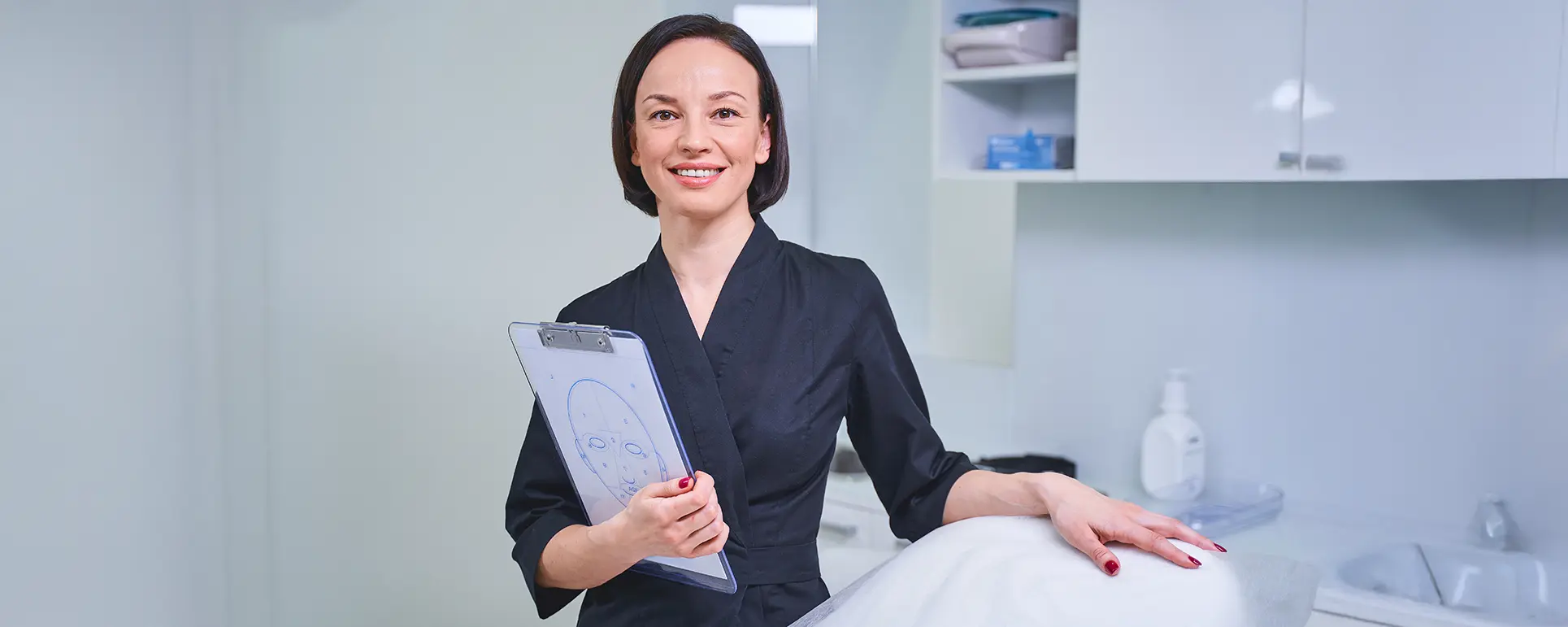Dermatology is often thought of as a specialty concerned mainly with common issues like acne, skin rashes, or cosmetic treatments. Yet, the reality of this field is far more intricate, intellectually engaging, and profoundly impactful. A dermatologist’s typical day is filled with a wide range of responsibilities, from diagnosing complex and serious skin conditions to performing delicate surgical procedures, analysing biopsy results, mentoring junior colleagues, conducting cutting-edge research, and continually updating their knowledge with the latest scientific developments.
The role of a dermatologist extends well beyond the confines of the clinic room. It involves a careful balance of medical, surgical, educational, and administrative duties. Whether managing chronic skin diseases, detecting early signs of melanoma, or advising patients on advanced aesthetic techniques, dermatologists must seamlessly integrate clinical expertise with empathetic communication and precise clinical judgement. Each day presents fresh challenges and opportunities to enhance patients’ well-being, making dermatology both demanding and exceptionally rewarding. Moreover, dermatologists often find themselves at the forefront of medical innovation, contributing to the development of new treatments and technologies that transform patient care. Their work not only addresses visible skin conditions but also tackles systemic diseases with dermatological manifestations, bridging multiple medical disciplines. This blend of patient-centred care, scientific inquiry, and technological advancement makes dermatology a uniquely stimulating and evolving specialty.
I take you behind the scenes to explore a typical day in the life of a dermatologist. I will highlight the multifaceted nature of the profession, shedding light on how dermatologists juggle patient care with ongoing professional development, interdisciplinary teamwork, and teaching responsibilities. Whether you are a medical student considering a career in dermatology, a healthcare professional interested in the specialty, or simply curious to learn more, this piece offers an insightful and comprehensive glimpse into one of the most dynamic and rapidly evolving branches of modern medicine.
Early Morning Preparation and Patient Reviews
The day for a dermatologist often begins well before the first patient walks through the door. This quiet period is dedicated to a series of important preparatory activities that set the stage for efficient and effective patient care:
- Carefully reviewing the day’s appointment schedule to anticipate patient flow and complexity
- Checking for any urgent lab results or test reports that may impact clinical decisions
- Updating electronic medical records to ensure all patient information is current and accurate
- Responding thoughtfully to patient messages and inquiries received outside clinic hours
- Communicating with general practitioners and other healthcare professionals regarding referrals or follow-up care
This time is essential not only for administrative duties but also for mental and clinical preparation. It allows dermatologists to familiarize themselves with the range of cases they will encounter, particularly identifying patients who might need additional appointment time or coordination with other specialists. By reviewing complex or challenging cases ahead of time, dermatologists can gather relevant resources, recent medical literature, or visual aids that will support more informed decision-making and enhance patient education during consultations.
This calm, focused period before the clinical day begins helps set a positive and productive tone, ensuring that the dermatologist is fully briefed, organised, and ready to provide the highest standard of care throughout the day.
Outpatient Consultations Begin
Outpatient clinics form a major part of a dermatologist’s daily routine. Patients come with a wide range of skin conditions, from common issues like eczema and psoriasis to more complex autoimmune or infectious diseases. Some visits focus on managing long-term conditions, while others involve assessing new or undiagnosed problems that require thorough investigation. This diversity keeps each clinic session engaging and mentally challenging.
During every consultation, the dermatologist takes a detailed medical history and performs a careful skin examination. Often, this includes using tools like dermatoscopes or digital imaging to get a closer look at the skin. Managing time well is crucial, as appointments are usually booked in 15 to 30-minute slots. Despite the tight schedule, it’s important for dermatologists to stay fully present and empathetic, ensuring patients feel listened to and understood. Accurate and efficient documentation is also essential to keep patient records current and comprehensive.
Patient education plays a vital role in these clinics too. Dermatologists often take time to clearly explain diagnoses and discuss personalised treatment plans, helping patients feel more informed and confident about their care.
Performing Minor Surgical Procedures

Many dermatologists are trained to perform surgical procedures right in the clinic, including mole removals, biopsies, and cyst excisions. These minor surgeries often follow morning consultations.
Surgical precision is essential, especially when lesions are located in cosmetically sensitive areas like the face or neck. Each case must balance oncologic safety and aesthetic outcomes.
Proper patient consent, sterile technique, and post-operative instructions are all vital parts of this process. These small procedures can have big impacts, both medically and cosmetically.
Midday Multidisciplinary Case Discussions
Around midday, dermatologists often participate in multidisciplinary team (MDT) meetings. These sessions bring together specialists from various fields to collaborate on complex skin cases, especially those involving cancer.
- Dermatologists, oncologists, pathologists, and surgeons join forces to review challenging cases
- Discussion focuses on refining diagnoses and deciding on the best treatment strategies
- The team-based approach ensures comprehensive care for patients with skin cancers or rare dermatologic syndromes
These collaborative meetings are vital for coordinating care plans involving surgery, immunotherapy, radiation, or other advanced treatments. By combining expertise, the team enhances patient outcomes through well-rounded, evidence-based decisions.
Beyond clinical decision-making, MDT meetings also provide an opportunity for ongoing professional development. Specialists share the latest research findings, discuss emerging therapies, and review case outcomes, fostering a culture of continuous learning and innovation within dermatology and related disciplines.
Histopathology Review and Diagnosis
In the afternoon, dermatologists dedicate time to reviewing skin biopsy slides alongside dermatopathologists. This collaborative process is crucial for confirming diagnoses that may not be clear from clinical examination alone.
- Examining the microscopic structure of skin tissue to identify abnormalities
- Differentiating between benign lesions and malignant conditions such as basal cell carcinoma or melanoma
- Correlating clinical information with histopathological findings to ensure diagnostic accuracy
This task is among the most intellectually challenging aspects of dermatology. It requires combining detailed clinical clues with microscopic analysis to guide precise and timely treatment decisions, ultimately improving patient outcomes. In addition to diagnosis, histopathology review plays a vital role in monitoring treatment effectiveness and detecting any signs of recurrence or complications. Dermatologists use these insights to adjust treatment plans and provide personalised care, ensuring patients receive the best possible outcomes throughout their journey.
Moreover, continuous engagement with histopathology advances a dermatologist’s knowledge of emerging skin diseases and novel diagnostic techniques. This ongoing learning supports innovation in patient care and reinforces the importance of a multidisciplinary approach within dermatology practice.
Coordinating with General Practitioners
Dermatologists frequently engage in close collaboration with general practitioners (GPs), who serve as the first point of contact and often refer patients requiring specialised dermatological care. Maintaining clear and consistent communication with GPs is vital for accurately clarifying diagnoses, reviewing and adjusting medication regimens, and ensuring that follow-up care plans are effectively coordinated. This ongoing dialogue helps bridge gaps between primary and specialist care, fostering a more holistic approach to patient management.
Collaborative care between dermatologists and GPs significantly improves patient outcomes by enabling more precise treatment strategies and reducing the risk of redundant tests or overlapping prescriptions. GPs rely heavily on the specialised knowledge and insights of dermatologists, particularly when managing chronic, complex, or unclear skin conditions that require expert evaluation and tailored interventions.
Building and nurturing strong professional relationships with local GP practices also contributes to enhanced community healthcare. It ensures that patients experience a seamless continuum of care, receiving timely assessments and treatments across different levels of the healthcare system. This integrated approach not only streamlines patient journeys but also promotes better resource utilisation, patient satisfaction, and overall public health. Key benefits include:
- Improved coordination of care: Ensures that treatment plans are consistent and well-communicated between specialists and primary care providers.
- Enhanced patient experience: Patients receive quicker access to the right care at the right time, reducing delays and unnecessary hospital visits.
Teaching and Mentoring Junior Doctors
Dermatologists play an active role in teaching, whether by supervising junior doctors during clinic sessions or delivering formal presentations during hospital teaching rounds. Sharing clinical knowledge and practical skills is a fundamental part of their professional responsibility and commitment to advancing the specialty.
- Supervising trainees as they develop skills in skin examination, diagnosis, and patient communication
- Guiding junior doctors through complex case discussions and clinical decision-making
- Delivering structured teaching sessions that cover the latest research, treatment protocols, and dermatological techniques
Junior doctors often shadow experienced consultants to observe and learn the subtleties involved in dermatological practice. This hands-on mentorship is essential for building competence and confidence, shaping the future generation of dermatologists.
Attending Clinical Research Meetings
Many dermatologists actively engage in clinical trials, academic research, and collaborative studies with pharmaceutical and biotech companies. Throughout the week, they attend research meetings to track study progress, verify data accuracy, ensure adherence to protocols, and review interim results.
Participation in research keeps dermatologists at the cutting edge of medical innovation, enabling them to contribute to the creation of new therapies and diagnostic techniques. It also offers valuable insights into applying emerging scientific evidence to clinical practice, ultimately enhancing patient care.
These sessions often cover topics such as research ethics, securing funding for upcoming projects, and peer-reviewing manuscripts prior to publication. Additionally, journal clubs are commonly held, where dermatologists critically appraise recent studies to evaluate their clinical significance and methodological quality.
Administrative Responsibilities and Audits

Behind the scenes, dermatologists manage a range of important administrative duties that are crucial to maintaining high standards of care. These responsibilities often include reviewing audit results to identify areas for improvement, updating clinical guidelines to reflect the latest evidence, and enhancing documentation processes for greater accuracy and efficiency.
Dermatologists also contribute to departmental leadership and management, playing an active role in shaping policies that ensure clinical practices comply with national and institutional standards. Their involvement helps to foster a culture of continuous quality improvement within the dermatology unit.
Though less visible than direct patient care, these administrative tasks are essential to the smooth and effective operation of dermatology services. They support quality assurance initiatives, enhance patient safety, and drive long-term advancements in the delivery of dermatological care.
Emergency Dermatology Referrals
Despite a busy and tightly scheduled day, dermatologists must remain adaptable to manage urgent cases as they arise. These emergencies can include rapidly spreading rashes, suspected skin infections, or severe allergic reactions that require immediate attention.
Emergency referrals typically come from accident and emergency (A&E) departments or other hospital units. Dermatologists are often required to perform swift assessments, provide accurate diagnoses, and begin urgent treatment plans within a limited timeframe to prevent complications.
Being on call for emergency dermatology cases demands both agility and expertise. The role requires:
- Rapid decision-making: The ability to quickly evaluate symptoms and determine the appropriate course of action without delay.
- Confidence under pressure: Maintaining composure while handling complex or potentially life-threatening skin conditions to ensure patient safety and effective care.
End-of-Day Case Documentation and Learning
As the day winds down, dermatologists catch up on documentation, review patient notes, and update treatment plans. This administrative time ensures that no clinical details are missed. Accurate records are essential for continuity of care, legal compliance, and seamless communication with other healthcare providers. It also allows time to flag cases that may need follow-up or additional testing.
Some use the quiet hours to review dermatology journals, prepare lectures, or attend webinars. Continuous learning is built into their daily routine. They may also engage in case discussions with peers or contribute to online forums and academic networks. Sharing knowledge helps strengthen the wider dermatological community.
Staying updated with emerging therapies and diagnostic tools is not just a requirement it’s a passion that drives excellence in the field. This commitment to learning ensures that patients receive the most current, evidence-based care. It also fosters innovation and inspires new approaches to complex skin conditions.
Speaking at Conferences and Webinars

Experienced dermatologists frequently take part in medical conferences, workshops, and online webinars to share their clinical insights, research findings, and innovative approaches. These events provide valuable opportunities to contribute meaningfully to the broader medical community.
At such gatherings, dermatologists may present complex clinical cases, engage in expert panel discussions, or lead specialised training sessions for peers and trainees. These interactions foster professional networking, encourage the exchange of ideas, and help participants stay updated on the latest global trends and advancements in dermatology.
Moreover, public speaking and teaching at these events enhance a dermatologist’s professional credibility and communication skills. Many find this aspect of their work deeply rewarding, as it allows them to inspire colleagues and nurture the next generation of dermatology specialists.
Advising on Skincare Product Development
Many dermatologists actively collaborate with pharmaceutical companies, cosmetic manufacturers, and skincare brands to provide expert consultation during the development of new skincare products. Their clinical expertise is invaluable in ensuring that formulations are both safe and effective for a wide range of skin types and conditions.
In this collaborative role, dermatologists often contribute by:
- Testing product prototypes: Assessing how formulations perform on different skin types and identifying any potential irritants or adverse reactions.
- Analysing ingredients: Evaluating the scientific evidence behind active components to ensure they deliver the promised benefits without compromising safety.
- Co-authoring product guidelines: Helping to create accurate and informative usage instructions and marketing materials that reflect clinical best practices.
Scientific validation is crucial for building patient and consumer trust. By integrating rigorous clinical research into product development, dermatologists help raise the standard of skincare offerings on the market.
This role represents a vital bridge between clinical dermatology and consumer needs, transforming complex scientific findings into practical, accessible skincare solutions. Through their involvement, dermatologists ensure that products not only meet real patient requirements but also adhere to the highest levels of safety, quality, and efficacy—ultimately improving skin health outcomes for users worldwide.
Final Thoughts: The Dermatologist’s Role Explained
The daily routine of a dermatologist is filled with variety, challenge, and purpose. From diagnosing life-threatening skin diseases to guiding patients through cosmetic treatments and offering mentorship to younger doctors, dermatologists wear many hats throughout their day. Their schedules require precision, compassion, communication, and adaptability, balancing clinical practice with academic and research pursuits.
Beyond medical treatment, dermatologists play an integral role in empowering patients through education and preventative care. They often serve as the first line of defence against serious conditions like skin cancer, while also helping patients manage chronic skin disorders that affect their quality of life. Each interaction whether in clinic, theatre, or classroom adds depth to their impact on public health.
Dermatologists play a vital role beyond clinical care driving innovation in aesthetics, guiding product development, and engaging in community outreach. Their work doesn’t stop at the end of the clinic day; it extends into research, health policy, and continuous professional development. This dynamic field proves that dermatology is much more than skin deep. To learn how our expert dermatologists support patients both in and out of the clinic, get in touch to book a personalised consultation.
References:
- Smith, L.A., Johnson, D.W. and Patel, R.K., 2021. The scope of clinical dermatology: Trends and challenges in daily practice. British Journal of Dermatology, 184(5), pp.789–797. Available at: https://onlinelibrary.wiley.com/doi/10.1111/bjd.19845
- Bolognia, J.L., Schaffer, J.V. and Cerroni, L., 2018. Dermatology. 4th ed. Elsevier. [Chapter: Clinical workflow and responsibilities].
- National Health Service (NHS), 2023. Working as a dermatologist. [online] Available at: https://www.healthcareers.nhs.uk/explore-roles/doctors/roles-doctors/medicine/dermatology
- Callen, J.P., 2020. Balancing clinical dermatology with teaching and research: A lifelong perspective. Journal of Investigative Dermatology Symposium Proceedings, 21(1), pp.12–15.
- Warshaw, E.M., Lee, G. and Storrs, F.J., 2019. Dermatology in academic and private practice: What differs in the day-to-day? Dermatologic Clinics, 37(1), pp.1–10. DOI: https://doi.org/10.1016/j.det.2018.07.003
